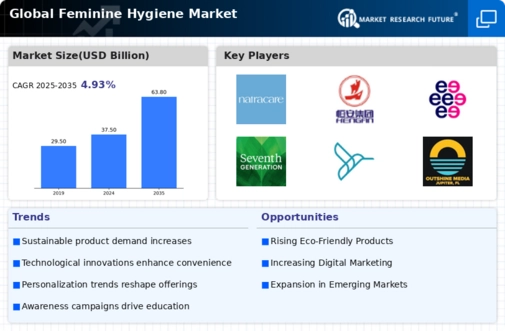Top Industry Leaders in the Feminine Hygiene Market
 The competitive landscape of the feminine hygiene market is characterized by a diverse range of key players, each employing distinct strategies to gain and maintain market share. As of 2023The industry is witnessing the emergence of new companies, while established players continue to adapt to changing market dynamics. This analysis delves into the strategies adopted by key players, factors influencing market shareThe presence of new and emerging companies, relevant industry news, investment trends, and the overall competitive scenario.
The competitive landscape of the feminine hygiene market is characterized by a diverse range of key players, each employing distinct strategies to gain and maintain market share. As of 2023The industry is witnessing the emergence of new companies, while established players continue to adapt to changing market dynamics. This analysis delves into the strategies adopted by key players, factors influencing market shareThe presence of new and emerging companies, relevant industry news, investment trends, and the overall competitive scenario.
Key Players:
- Procter and Gamble,
- Edgewell Personal Care,
- Unicharm Corporation,
- Kimberly-Clark Corporation,
- Lil-Lets Group Ltd,
- Svenska
- Cellulosa Aktiebolaget SCA,
- Johnson & Johnson,
- Ontex International,
- Natracare LLC,
- Kao Corporation
Strategies Adopted:
The key players in the feminine hygiene market deploy diverse strategies to maintain and enhance their market positions. Product innovation and development, strategic partnerships, mergers and acquisitions, and aggressive marketing campaigns are among the common strategies. Procter & Gamble, for instance, has consistently invested in research and development to introduce innovative products, while Kimberly-Clark Corporation has focused on strategic collaborations to expand its market share.
Factors for Market Share Analysis:
Market share analysis in the feminine hygiene sector is influenced by various factors. Brand recognition, product quality, pricing strategy, distribution channels, and consumer loyalty all contribute to the market share of a company. AdditionallyThe ability to adapt to changing consumer preferences and sustainability initiatives are increasingly becoming critical factors in determining market share.
New and Emerging Companies:
The feminine hygiene market is witnessing the entry of new and emerging companies that bring fresh perspectives and innovative solutions to the industry. Start-ups focused on sustainable and organic products are gaining traction, challenging traditional players. These companies often leverage e-commerce platforms and digital marketing to establish their presence in the market.
Industry News and Current Companies:
The feminine hygiene market is dynamic, with frequent industry news shaping the competitive landscape. Companies are actively participating in events, launching new products, and announcing strategic partnerships to strengthen their market positions. Staying abreast of industry news is crucial for understanding the evolving dynamics of the feminine hygiene market.
Investment Trends:
Investment trends in the feminine hygiene market reflect the industry's growth potential and attractiveness to investors. Venture capital investments in start-ups offering innovative and sustainable solutions have increased. Moreover, established players are allocating substantial resources to research and development to capitalize on emerging trends and gain a competitive edge.
Overall Competitive Scenario:
The overall competitive scenario in the feminine hygiene market is characterized by intense competition among key players, with a growing emphasis on sustainability and innovation. Companies are vying for consumer attention by differentiating their products through eco-friendly materials, unique formulations, and improved functionality. The market's competitive nature is also fostering collaborations and partnerships between companies seeking synergies to strengthen their positions.
Recent Development
The feminine hygiene market witnessed several notable developments. Procter & Gamble, a market leader, unveiled a line of eco-friendly and biodegradable sanitary products, aligning with the increasing consumer demand for sustainable options. Kimberly-Clark Corporation announced a strategic alliance with a leading e-commerce platform to enhance its online presence and improve accessibility for consumers.
Johnson & Johnson introduced a marketing campaign highlighting the health benefits of its feminine hygiene products, aiming to educate consumers and build brand loyalty. Essity AB expanded its product portfolio with the launch of innovative menstrual hygiene products designed for comfort and discretion. Unicharm Corporation, recognizing the importance of digital platforms, invested in advanced e-commerce infrastructure to streamline online sales.
In terms of new and emerging companies, several start-ups gained attention for their focus on eco-friendly and organic feminine hygiene products. These companies leveraged social media platforms to connect with environmentally conscious consumers, contributing to the diversification of product offerings in the market.
Industry news highlighted a growing trend of mergers and acquisitions within the feminine hygiene sector. Companies sought strategic alliances to strengthen their market positions and capitalize on complementary strengths. These developments underscore the industry's dynamic nature and the continuous efforts of key players to adapt to evolving consumer preferences.
Investment trends reflected a sustained interest in companies promoting sustainability and innovation. Venture capital firms directed funding towards start-ups with novel solutions, while established players allocated significant resources to research and development initiatives. The overall competitive scenario remained robust, with companies navigating the complexities of a rapidly evolving market landscape.










